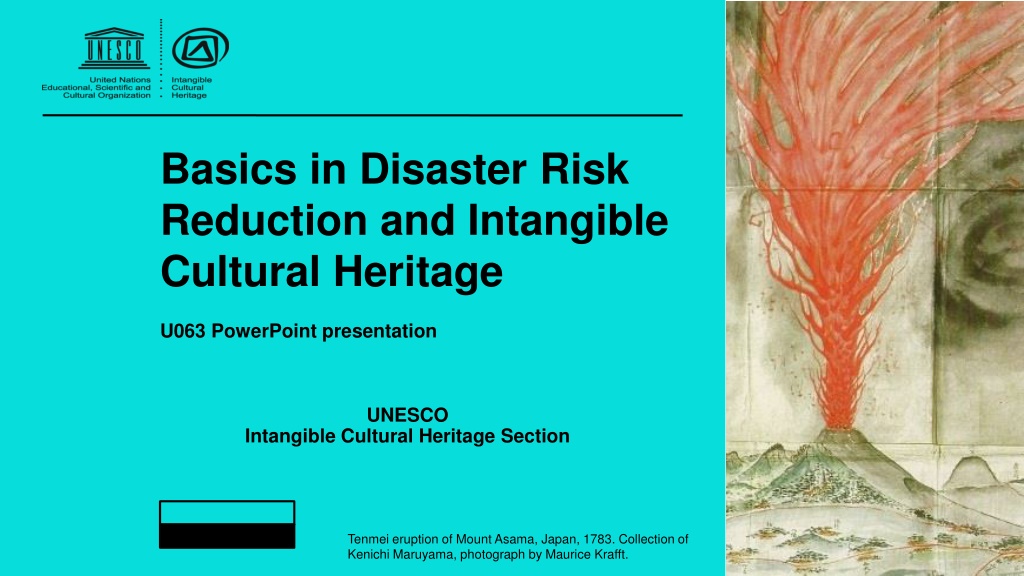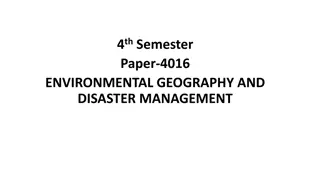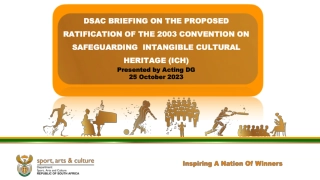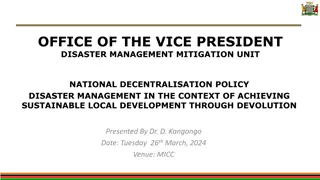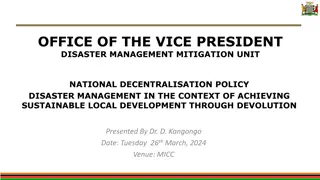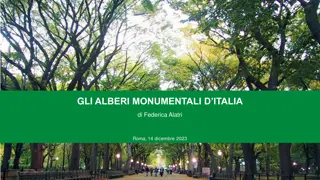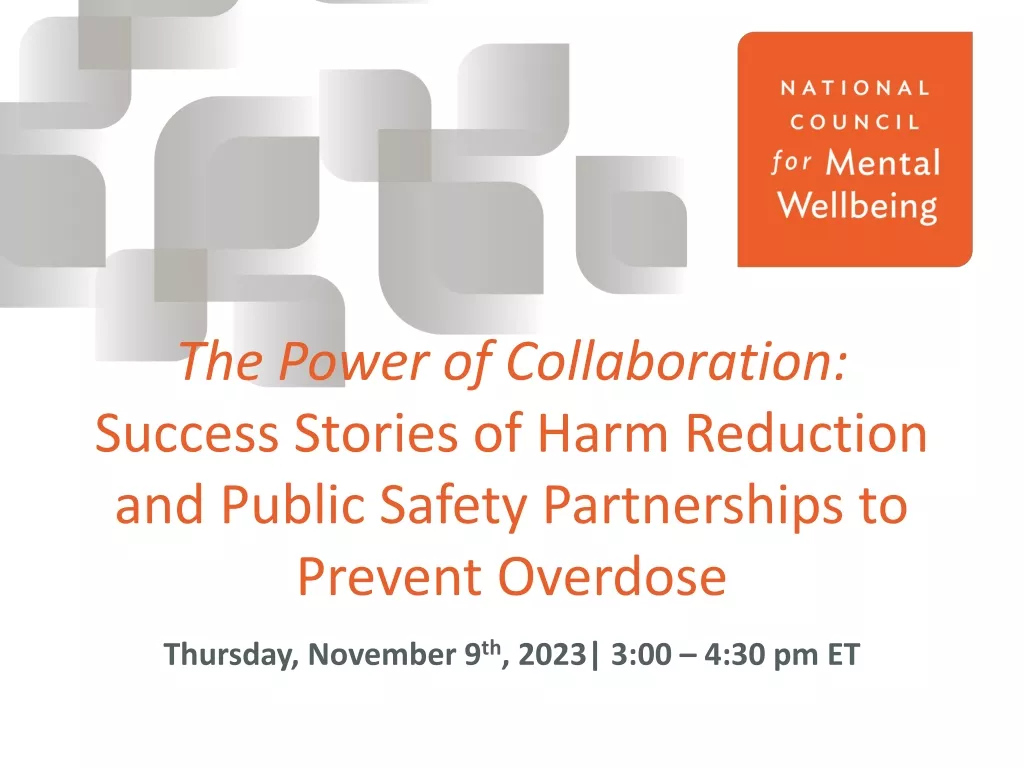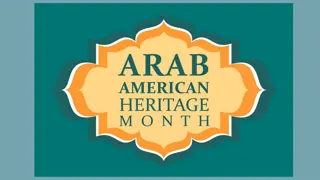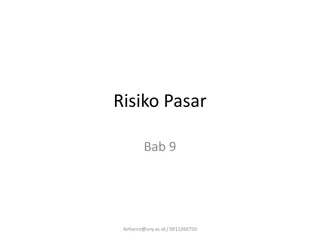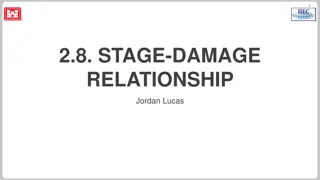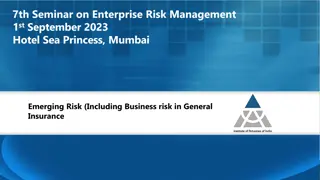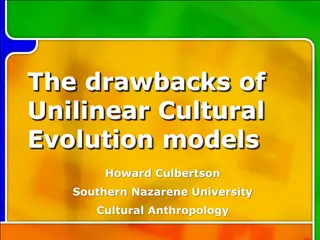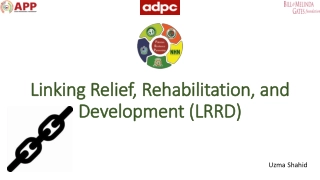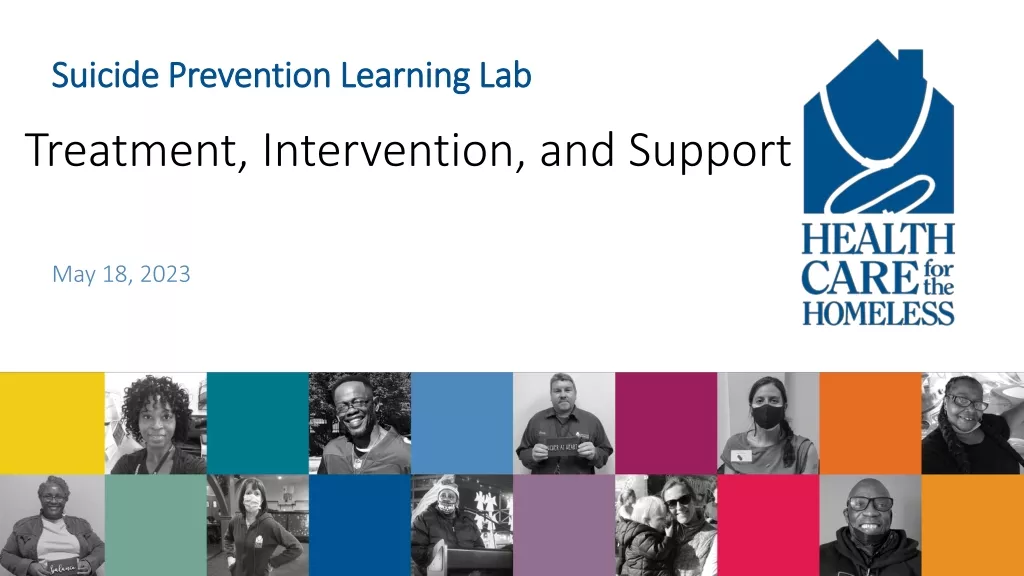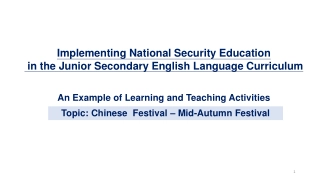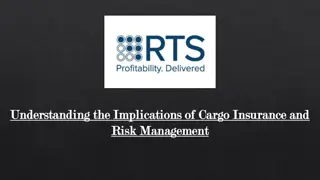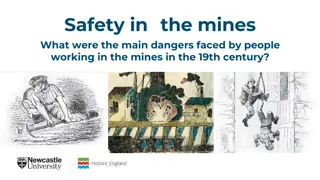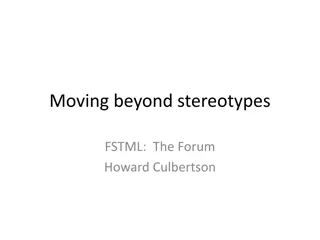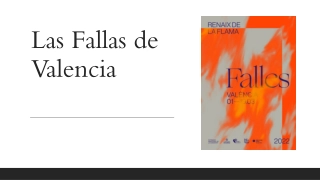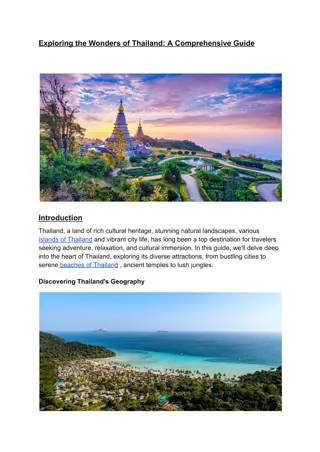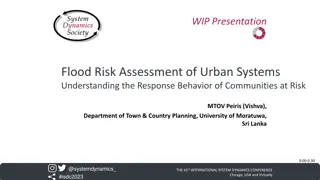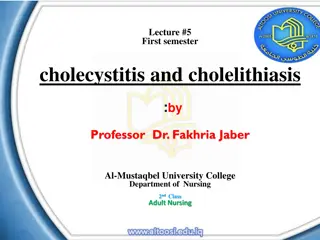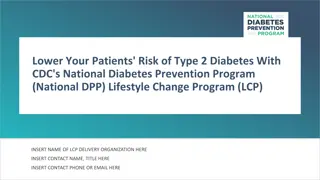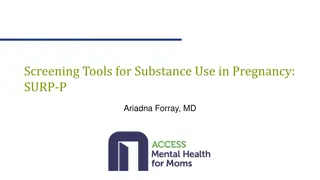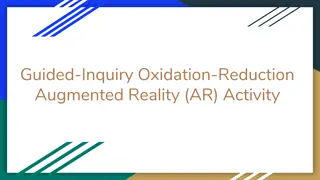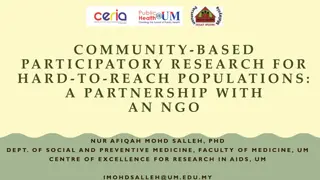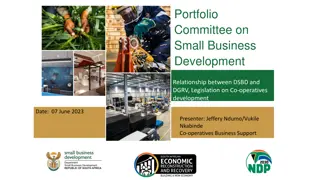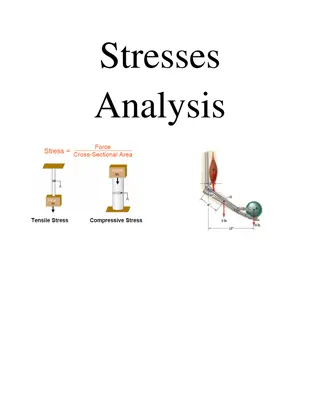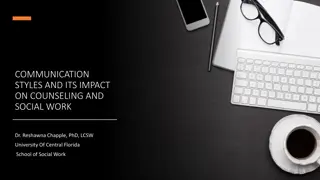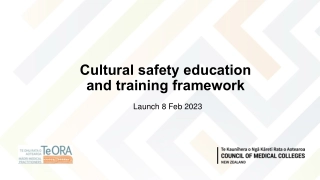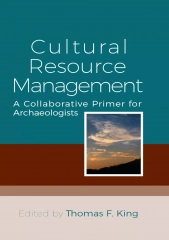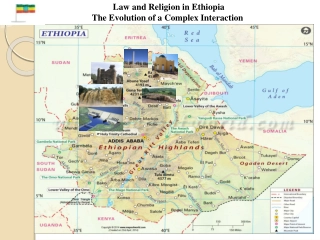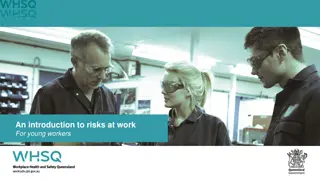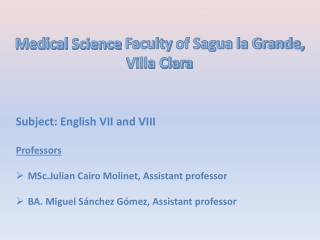Understanding the Relationship Between Intangible Cultural Heritage and Disaster Risk Reduction
This PowerPoint presentation by UNESCO explores the connection between Intangible Cultural Heritage (ICH) and Disaster Risk Reduction (DRR). It covers key concepts like disasters, risks, vulnerabilities, and resilience, emphasizing the importance of safeguarding and mobilizing ICH in the face of disasters. Through examples like the Tenmei eruption of Mount Asama in Japan, it highlights the dual role of ICH in both being impacted by disasters and contributing to their mitigation. The workshop aims to equip participants with knowledge on frameworks, roles of different stakeholders, and assessing risks using tools like the World Risk Index.
Understanding the Relationship Between Intangible Cultural Heritage and Disaster Risk Reduction
PowerPoint presentation about 'Understanding the Relationship Between Intangible Cultural Heritage and Disaster Risk Reduction'. This presentation describes the topic on This PowerPoint presentation by UNESCO explores the connection between Intangible Cultural Heritage (ICH) and Disaster Risk Reduction (DRR). It covers key concepts like disasters, risks, vulnerabilities, and resilience, emphasizing the importance of safeguarding and mobilizing ICH in the face of disasters. Through examples like the Tenmei eruption of Mount Asama in Japan, it highlights the dual role of ICH in both being impacted by disasters and contributing to their mitigation. The workshop aims to equip participants with knowledge on frameworks, roles of different stakeholders, and assessing risks using tools like the World Risk Index.. Download this presentation absolutely free.
Presentation Transcript
Basics in Disaster Risk Reduction and Intangible Cultural Heritage U063 PowerPoint presentation UNESCO Intangible Cultural Heritage Section Tenmei eruption of Mount Asama, Japan, 1783. Collection of Kenichi Maruyama, photograph by Maurice Krafft.
Goals and scope of this workshop Goal: to introduce participants to the relationship between Intangible Cultural Heritage (ICH) and Disaster Risk Reduction (DRR) Scope: 1. key disaster concepts and terms 2. relevant frameworks, instruments and standards 3. the dual role of ICH in disasters: a) how ICH is impacted by disaster, and b) how ICH can be mobilized or contribute to reducing the effects of disaster 4. roles for communities, experts, humanitarian organizations and other stakeholders in safeguarding and mobilizing ICH in the context of disasters. 2
Key concepts and terms: disaster Disaster: A serious disruption of the functioning of a community or a society involving widespread human, material, economic or environmental losses and impacts, which exceeds the ability of the affected community or society to cope using its own resources. (UNISDR 2009) There are no natural disasters Disasters have their origins in either natural hazards (such as cyclones or earthquakes) or human-made events (such as nuclear or chemical accidents), and become disasters because of the ways in which local populations and environments are already vulnerable Disasters, epidemics and conflicts are all forms of emergency, but they can overlap with or trigger or amplify each other. 3
Key concepts and terms: risk, vulnerability, resilience The severity of a disaster is a combination of the risk of an event, and the balance between the vulnerability and resilience of a landscape and its population. Risk: The combination of the probability of an event and its negative consequences. What are the chances an event will happen? How would it impact, and how? Vulnerability: The characteristics and circumstances of a community, system or asset that make it susceptible to the damaging effects of a hazard. How exactly are communities and environments exposed to risk? Resilience: The ability of a system, community or society exposed to hazards to resist, absorb, accommodate to and recover from the effects of a hazard in a timely and efficient manner, including through the preservation and restoration of its essential basic structures and functions. 4
Components of the World Risk Index Source: https://www.ireus.uni-stuttgart.de/en/International/WorldRiskIndex/ 6
Exercise 1: The World Risk Index https://weltrisikobericht.de/ Estimates the exposure to natural hazards faced by 193 countries (as of 2022), and assesses: inherent vulnerability to impact from disaster (including current infrastructure, living conditions, economic circumstances and nutrition) capacity to cope with disaster (preparedness, social security and governance) capacity to adapt to climate change and the impending threat of hazards. Questions for Exercise 1: What is the risk ranking of your country? (where 1 = highest risk of disaster, 193 = lowest) What factors contribute to that exposure rank? What might this mean for ICH safeguarding and inventorying in your country? 7
Responding to disaster: DRM and DRR Disaster Risk Management (DRM): The systematic process of using administrative directives, organizations, and operational skills and capacities to implement strategies, policies and improved coping capacities in order to lessen the adverse impacts of hazards and the possibility of disaster. Disaster Risk Reduction (DRR): The concept and practice of reducing disaster risks through systematic efforts to analyse and manage the causal factors of disasters, including through reduced exposure to hazards, lessened vulnerability of people and property, wise management of land and the environment, and improved preparedness for adverse events. DRM tends to deal with consequences, but DRR anticipates 8
Disaster Management Cycle An endless cycle, broken into three or more phases, which can vary in duration and often overlap with each other: Preparedness (and Prevention / Mitigation): The knowledge and capacities developed by governments, professional response and recovery organizations, communities and individuals to effectively anticipate, respond to, and recover from, the impacts of likely, imminent or current hazard events or conditions. Response: The provision of emergency services and public assistance during or immediately after a disaster in order to save lives, reduce health impacts, ensure public safety and meet the basic subsistence needs of the people affected. Recovery: The restoration, and improvement where appropriate, of facilities, livelihoods and living conditions of disaster-affected communities, including efforts to reduce disaster risk factors. 9
Consideration of ICH in DRR DRR approaches have tended to focus on: tangible or built heritage over intangible heritage specific ICH that is used to model useful practices or early warnings refers not to ICH, but instead to traditional / Indigenous / local knowledge Now there is increasing acknowledgment of the importance of local / traditional / Indigenous knowledge in the DRR approaches and instruments: Especially in the Mid-Term Review of the Sendai Framework for Disaster Risk Reduction 2015-2030 (2022) 10
Post-Disaster Needs Assessment (PDNA) Post-Disaster Needs Assessments (PDNAs) a formal process of evaluation established since 2008 determines physical damages and economic losses to all sectors of society within weeks of disaster forecasts the cost of recovery needs separate chapter on culture since 2013 but focus is on tangible heritage ICH not easily integrated within PDNA process because: ICH is not easily valued in monetary terms limited availability of baseline ICH inventories ICH often narrowly or poorly defined protocols for collecting ICH data are not well established lack of formal mechanisms for later evaluation or monitoring of PDNA assessments 11
DRR in the 2003 ICH Convention and Operational Directives Disasters and DRR do not feature strongly in either the 2003 Convention or the Operational Directives, but are specifically addressed at the following locations: Disasters defined for the purpose of requesting emergency International Assistance. (OD Article 22.2 and Paragraph 50) Expedited process for a nomination to the List of Intangible Cultural Heritage in Need of Urgent Safeguarding in cases of extreme urgency (OD Article 17.3 and Paragraph 32) Community-based resilience to natural disasters and climate change , which promotes respect for knowledge and practices relating to natural phenomena, including disasters, and the need to harness their potential to contribute to the reduction of risk [and] recovery from natural disasters (OD Chapter VI.3.3) 12
The UNESCO Strategy and Emergencies Addendum (2017) to the Strategy for the Reinforcement of the UNESCO s action for the Protection of Culture and the Promotion of Cultural Pluralism in the Event of Armed Conflict, aims to: (1) strengthen the ability of Member States to prevent, mitigate and recover the loss of cultural heritage and diversity as a result of disasters caused by natural and human-induced hazards. (2) incorporate consideration for culture into the DRR sector and humanitarian action related to disasters by engaging with the relevant stakeholders outside the cultural domain. World Heritage Committee s Strategy for Disaster Risk Reduction at World Heritage Properties (2007) 2003 Convention s Operational Principles and Modalities for Safeguarding Intangible Cultural Heritage in Emergencies (2019) 13
ICH Disaster Risk integrating ICH and DRR ICH Disaster Risk is the interaction between a particular threat or hazard and the vulnerability of an ICH element or practice. How do we bring an understanding and awareness of DRR to the challenge of inventorying and safeguarding ICH? And how do we introduce an understanding and awareness of ICH amongst the groups and systems that manage disasters and disaster risk? (e.g. involvement of ICH practitioners in Post-Disaster Needs Assessment (PDNA) process) 14
Operational Principles Operational Principles and Modalities for Safeguarding Intangible Cultural Heritage in Emergencies (2019) Six basic Operational Principles: 1. 2. Central importance of lives and well-being of ICH bearers Expanded understanding of affected communities, including hosts, displaced persons Community-based inventorying essential in all phases of disaster management cycle States Parties to ensure widest possible participation of ICH bearers State and non-state humanitarian actors to support ICH bearers in safeguarding and mitigating actions Respect for the dynamic and adaptive nature of ICH 3. 4. 5. 6. 15
Operational Modalities - Preparedness The operational modalities implement and integrate the principles by defining appropriate action for each phase: 1. Raise awareness and build capacity of relevant stakeholders regarding dual nature of ICH in disasters Resource and support communities to engage in DRR Integrate information on vulnerability of ICH to potential disasters in inventories Include DRR measures in ICH safeguarding plans of specific elements Incorporate relevant ICH in local, national, sub-regional and regional DRR plans Link ICH safeguarding and DRR bodies 2. 3. 4. 5. 6. 16
Operational Modalities - Response 1. Identify and reach out to ICH bearers known or likely to have been affected by the disaster, as early as possible. Resource and support ICH bearers to identify and address immediate safeguarding needs and to draw on ICH to mitigate immediate effects of the disaster Share information amongst other humanitarian actors to determine nature and extent of impact to ICH, and scope for engaging ICH in mitigation. Ensure that ICH is incorporated in post-disaster assessments (e.g. PDNAs) and that affected ICH bearers are involved in these assessments 2. 3. 4. 17
Operational Modalities - Recovery 1. Carry out community-based needs identification if this could not be done earlier. Resource and support ICH bearers to develop and undertake safeguarding measures or plans to enhance the mitigation capacity of their intangible cultural heritage. Engage ICH in fostering dialogue, mutual understanding and reconciliation between and within communities, including between displaced populations and host communities. 2. 3. 18
UNESCO Resources and Financial Support Resources that support the protection of ICH in the context of disaster include: Accelerated procedure for a nomination to the List of Intangible Cultural Heritage in Need of Urgent Safeguarding (see criterion U.6 under Chapter I.1 of the Operational Directives of the 2003 Convention). Financial and technical support can be sought from: UNESCO Heritage Emergency Fund Intangible Cultural Heritage Fund s International Assistance program 19
Inventorying ICH at risk of disaster Inventorying not a simple listing of intangible heritage elements raises awareness identifies elements with limited viability that may lead to safeguarding establishes relationships between stakeholders who may be involved in safeguarding boosts the sense of identity and continuity of the communities concerned creates greater awareness about ICH within and outside these communities. Inventorying with an awareness of disaster risk: identifying the risk from different hazards likely frequency, scale, etc mapping the viability of an ICH element across the different phases of the disaster cycle identifying which ICH might contribute to reducing the effects of disaster 20
Exercise 2: Sample framework analysis for ICH and DRR Question: What are the threats posed by potential emergencies to the continued practice and transmission of a selected ICH element? Steps: Each group to select one ICH element or practice make sure you have cultural permission to talk about this element or practice Start to fill out the Sample Inventorying Framework in Handout 1* Focus on the questions in Section 3 on viability Present to the workshop on just one of the questions in Section 3 We will build on these results in the next Unit, so save them! *Handout 1 is adapted from Unit 19, Developing an Inventory Framework Where no System Exists. 21
Wrapping up The concepts introduced in this unit are developed and put into practice in the exercises in Unit 64, Integrating Disaster Risk Reduction into ICH Inventorying. Any outstanding issues or questions from today s workshop? Homework tasks to complete before the next Unit Participants as well as observers should feel free to contact the trainer with any questions or queries or feedback about today s workshop: 22
